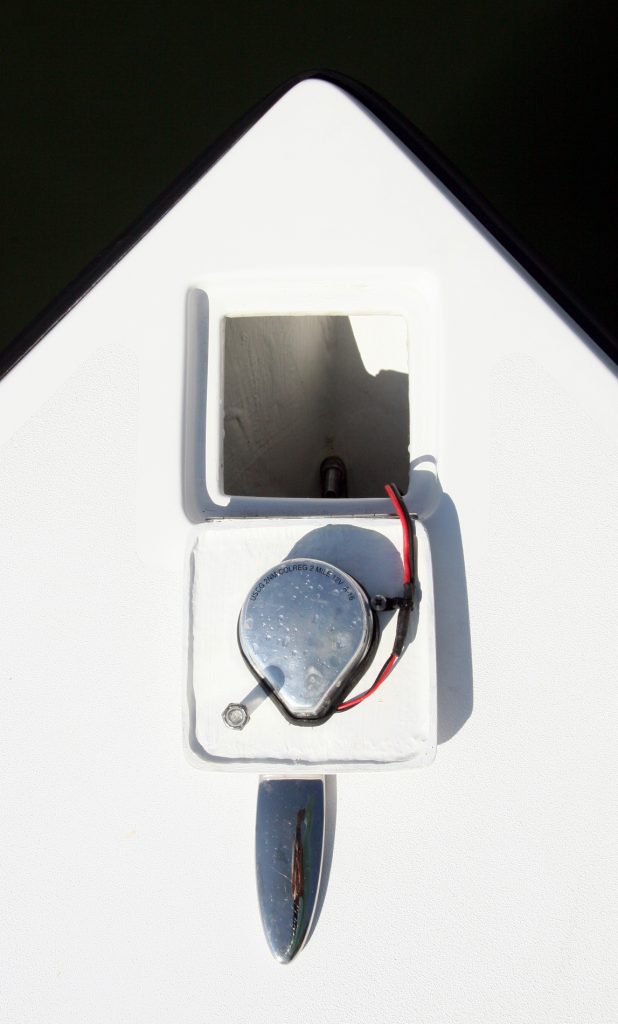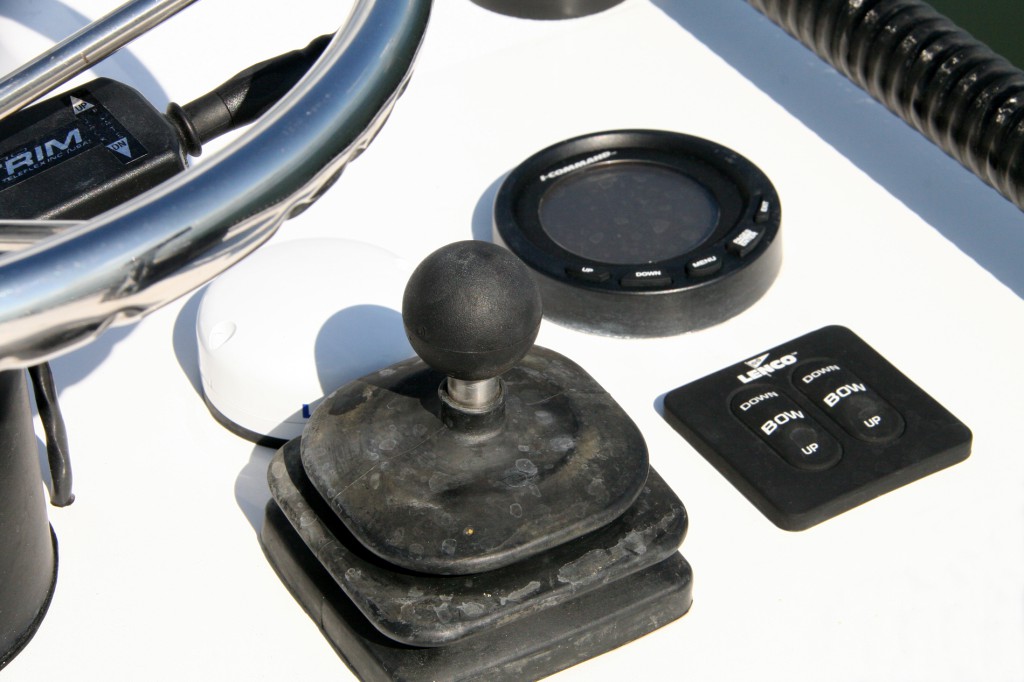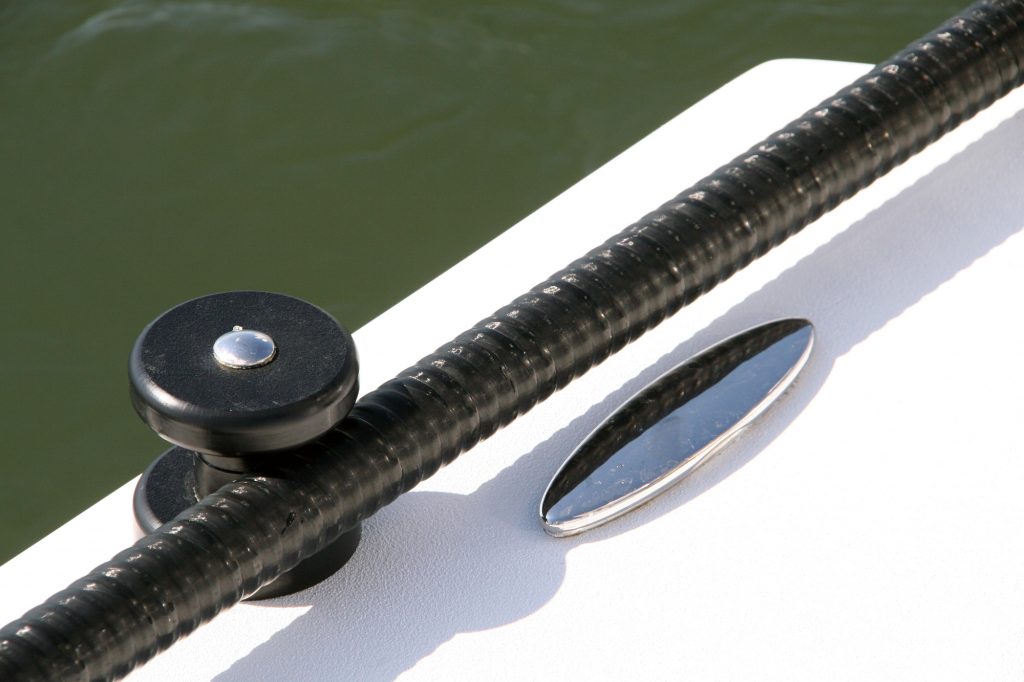June 23, 2014
By Florida Sportsman Staff

The Shipoke 18 hull has been around since 1973. New owners gave it an overhaul.
Chris Homer, Tri Pham and Eugene Son launched Shipoke Custom Boatworks intent on updating the Shipoke 18. The Shipoke 18 hull has been around since 1973, and the incredible ride was not something they wanted to experiment with. Original Shipoke owners tend to hold onto their boats—just ask Florida Sportsman Contributing Editor Tommy Thompson.
Instead they lightened the hull weight with upgraded hull construction material, rigged all the wiring for easy use, and even made available a center console. The original 1,300-pound hull was reduced to 900 pounds by integrating biaxial cloth into the laminate. Plus, original wood-stringer construction was updated to a fiberglass grid that's bonded to the hull and then foam-injected. The wood transom is replaced with composite Nilaboard, and finished dry storage and livewells are new.
Additionally, a sealed battery compartment is integrated into the bow to keep batteries out of the bilge and to offset heavier accessories at the stern. Each boat is wired with labeled fuse panels, tinned wiring and all devices run to terminal blocks. Each switch panel on the hand-laid Shipoke 18 is custom built with sealed Cole Hersee switches rather than prefab panels.
Chris and Eugene brought the boat over to Jensen Beach for a morning test on the Intracoastal Waterway. That Cadillac-smooth ride is still there, along with an exciting number of boater-friendly upgrades.
Shipoke Custom Boatworks
www.shipokeboats.com
Chris@shipokeboats.com
727-560-7688
Shipoke 18 Specifications:
Length Overall: 18 feet
Beam: 7 feet
Fuel capacity: 29 gallons
Loaded weight: 1,600 pounds
Draft: 10 inches
Maximum horsepower: 150 hp
Deadrise: 20 degrees
Occupancy: 5 people (or 1,000 pounds)
Base price (without engine): $27,000
 Some features are still “old school.” This flip-up bow light closes out of sight when not in use—just one less obstacle for fly line to tangle with. Many features on this boat are fly fishing friendly. Notice the lack of a bow-mount trolling motor. More on that later.
Some features are still “old school.” This flip-up bow light closes out of sight when not in use—just one less obstacle for fly line to tangle with. Many features on this boat are fly fishing friendly. Notice the lack of a bow-mount trolling motor. More on that later.
 Full size locker houses anchor, or doubles as a giant storage compartment. Bottom left, notice the tips of under-gunnel rod holders poking through—just enough room for most fly rods.
Full size locker houses anchor, or doubles as a giant storage compartment. Bottom left, notice the tips of under-gunnel rod holders poking through—just enough room for most fly rods.
 A sealed battery compartment houses four batteries at the bow. The batteries were specifically set forward to keep away from the bilge, plus to move weight to compensate for modern heavyweight engines, jack plates or stick anchors.
A sealed battery compartment houses four batteries at the bow. The batteries were specifically set forward to keep away from the bilge, plus to move weight to compensate for modern heavyweight engines, jack plates or stick anchors.
 There are four under-gunnel rod holders and a speaker both port and starboard. A complete JBL marine stereo system comes standard on the boat.
There are four under-gunnel rod holders and a speaker both port and starboard. A complete JBL marine stereo system comes standard on the boat.
 Pop-up holder handles most sizes of pushpoles. Leave the pushpole at the home, and all the deck and gunnels are flush.
Pop-up holder handles most sizes of pushpoles. Leave the pushpole at the home, and all the deck and gunnels are flush.
 Eugene Son runs the boat from the side console. Shipokes were traditionally built with side consoles, but a center console option is now available.
Eugene Son runs the boat from the side console. Shipokes were traditionally built with side consoles, but a center console option is now available.
 A close-up look at the side console. Clockwise from top left, engine trim, I-command gauge, Lenco trim tab controls, and joystick to maneuver tab-mounted trolling motors.
A close-up look at the side console. Clockwise from top left, engine trim, I-command gauge, Lenco trim tab controls, and joystick to maneuver tab-mounted trolling motors.
 A custom wireless remote pops out of the steering wheel hub to control the sound system. The remote works from as far away as 100 feet—perfect for chilling at the sandbar.
A custom wireless remote pops out of the steering wheel hub to control the sound system. The remote works from as far away as 100 feet—perfect for chilling at the sandbar.
 Below the side console to starboard is the CD player and switch panel. Close that door on the CD player and it's just about waterproof. Bottom right, LED-backlit, carbon-fiber switch panel is within arm's reach of the driver. Each panel is built with sealed Cole Hersee push-pull switches.
Below the side console to starboard is the CD player and switch panel. Close that door on the CD player and it's just about waterproof. Bottom right, LED-backlit, carbon-fiber switch panel is within arm's reach of the driver. Each panel is built with sealed Cole Hersee push-pull switches.
 Awlgrip nonskid on the Shipoke's deck keeps most anglers from slipping on their butts. Plus, it's an easy surface to clean and maintain. Custom graphics, like this Shipoke logo, can be incorporated into the nonskid surface.
Awlgrip nonskid on the Shipoke's deck keeps most anglers from slipping on their butts. Plus, it's an easy surface to clean and maintain. Custom graphics, like this Shipoke logo, can be incorporated into the nonskid surface.
 Soft cushioned bench seat is removed (not pictured) so that Eugene Son can open a portside hatch. The way this boat is rigged, there is no center console, so wiring and other hardware may be in different areas than one might expect. But because there is no center console, there is an abundance of foot space. Eugene recognizes the benefit of a wide-open cockpit to fishermen who must maneuver around the boat constantly, especially when hooked to a massive fish.
Soft cushioned bench seat is removed (not pictured) so that Eugene Son can open a portside hatch. The way this boat is rigged, there is no center console, so wiring and other hardware may be in different areas than one might expect. But because there is no center console, there is an abundance of foot space. Eugene recognizes the benefit of a wide-open cockpit to fishermen who must maneuver around the boat constantly, especially when hooked to a massive fish.
 Inside the bench seat compartment is (from left to right) a Lenco trim tab relay box, fuse panel, terminal block, and port and starboard breakers for trim tabs. Eugene says, “Each boat is wired like an offshore raceboat, with labeled fuse panels, tinned wiring and terminal blocks. An angler can replace a livewell or bilge pump in minutes with a screwdriver instead of spending an entire afternoon.”
Inside the bench seat compartment is (from left to right) a Lenco trim tab relay box, fuse panel, terminal block, and port and starboard breakers for trim tabs. Eugene says, “Each boat is wired like an offshore raceboat, with labeled fuse panels, tinned wiring and terminal blocks. An angler can replace a livewell or bilge pump in minutes with a screwdriver instead of spending an entire afternoon.”
 Twin livewells are available at the stern. LED lighting is standard under the gunnels, in livewells and inside the bilge compartment. At the poling platform, notice the steps and stakeout pole holder on each side. At the base of the platform, chrome rigging flanges and chrome bulkhead fittings for hydraulic lines are standard. The poling platform, built by Quality T-Tops in Tarpon Springs, is standard.
Twin livewells are available at the stern. LED lighting is standard under the gunnels, in livewells and inside the bilge compartment. At the poling platform, notice the steps and stakeout pole holder on each side. At the base of the platform, chrome rigging flanges and chrome bulkhead fittings for hydraulic lines are standard. The poling platform, built by Quality T-Tops in Tarpon Springs, is standard.
 Shipoke customized when it came to hardware, like this unique clamp to hold the pushpole. Custom pull-up cleats are used throughout the boat to prevent rattling noise.
Shipoke customized when it came to hardware, like this unique clamp to hold the pushpole. Custom pull-up cleats are used throughout the boat to prevent rattling noise.
 Inside the bilge compartment, pictured from left to right, Racor fuel filter, float switch, check valve for aerator filter, aerator pump, and terminal block. Everything is wide open, clean and easy to access.
Inside the bilge compartment, pictured from left to right, Racor fuel filter, float switch, check valve for aerator filter, aerator pump, and terminal block. Everything is wide open, clean and easy to access.
 A close-up of the terminal block. All devices run to terminal blocks with ring terminals, says Eugene, instead of butt connectors.
A close-up of the terminal block. All devices run to terminal blocks with ring terminals, says Eugene, instead of butt connectors.

Maximum horsepower on the Shipoke 18 is 150 hp, even though this Evinrude ETEC H.O. (High Output) likely gives it a bit more kick than its 150 moniker suggests. The Evinrude ETEC 150 features Uflex steering.
 A better look at the trim-tab mounted trolling motors. This boat was rigged for fly anglers, and stern mounted trolling motors are ideal to keep props away from fly line. Plus, many would say two trolling motors are better than one, especially when heading upcurrent or upwind. Hiding behind the pushpole is a 316 stainless stern eye, specifically chosen to prevent rust streaks.
A better look at the trim-tab mounted trolling motors. This boat was rigged for fly anglers, and stern mounted trolling motors are ideal to keep props away from fly line. Plus, many would say two trolling motors are better than one, especially when heading upcurrent or upwind. Hiding behind the pushpole is a 316 stainless stern eye, specifically chosen to prevent rust streaks.
 At the way back, Atlas 4-inch jackplate and custom transom plate are standard.
At the way back, Atlas 4-inch jackplate and custom transom plate are standard.
FS Classics, September 2011

